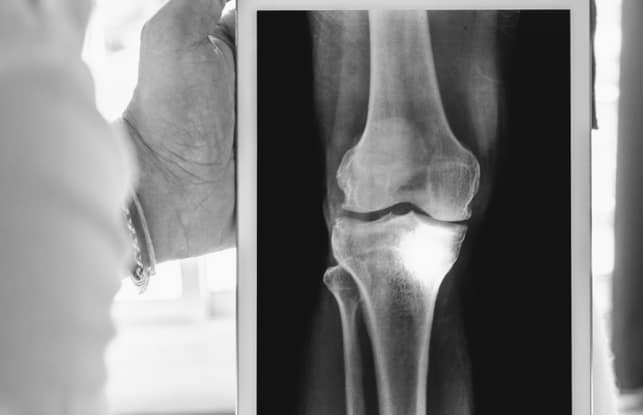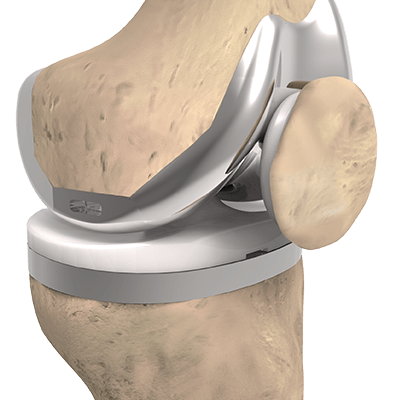Total Knee Replacement
With over 100,000 (1) total knee replacement procedures performed in the United Kingdom every year, total knee replacement surgery, also known as knee arthroplasty, is one of the most common joint replacement surgeries.
It is often performed to repair knee damage caused by arthritis or traumatic injury. Damage to the knee from wear and tear could easily lead to daily and debilitating pain that may require surgical intervention. Ask your physician whether a total knee replacement surgery is right for you or a loved one.
How Does Your Knee Work?
The knee is the largest hinge joint in the body (3). It is where the thigh bone (femur) and the shin bone (tibia) meet. The other bones that make up the knee include the fibula, the smaller bone that sits alongside the tibia, and the patella or knee cap. Tendons in the knee connect the bones to muscles and ligaments which join the knee bones together. The bone surfaces where the femur, tibia and patella meet are covered with cartilage, which helps to cushion the knee and keep it running smoothly. When all parts of the knee are working together, the knee operates smoothly to flex and extend the lower leg.
When the knee is diseased, degenerated, or experiences an injury, its natural balance and operation may be disrupted causing pain, weakness or other medical challenges.
What is a Total Knee Replacement Surgery?
Before considering a knee replacement surgery, many patients may go through a routine of conservative care starting with rest of the knee, lifestyle modification, pain and anti-inflammatory medications, and/or physical therapy. Those for whom this conservative treatment does not provide relief because the cartilage in the knee is too worn or there is damage to the bone surface, may have their physician recommend total knee replacement surgery or knee arthroplasty to alleviate the pain and get you back to living life.
In a total or partial knee replacement surgery, the surgeon removes the damaged cartilage and portions of the thigh bone, shin bone or patella, and replaces them with medical implants designed to replicate the knee joint so that the artificial joint can perform the motion and function of the natural knee without pain or compromise.
How is a Total Knee Replacement Surgery Performed?
Most total knee replacement surgeries take anywhere from 60 to 120 minutes to perform (4). During that surgical time, the surgeon makes an incision that is typically eight to ten inches in length stretching from the top of the knee to the bottom of the joint. This incision is made either down the centre or off to the side of the knee.
The surgeon then exposes the damaged area of the knee joint. During the surgery, the surgeon moves the kneecap (patella) aside and cuts away the damaged bone and cartilage. The surgeon will then replace the resected area with medical device implants that form an artificial joint designed to replicate the movement of a natural knee. A minimally-invasive knee replacement surgery minimises disruption of tissue surrounding the knee with incision as small as four to six inches (4).
What To Expect After Total Knee Replacement Surgery?
Physical therapy may begin the same day as your surgery starting with sitting on the edge of your bed, and then moving towards walking down the hall. Physical therapy may continue for up to three months after surgery (7).
Depending on your recovery and your surgeon’s recommendations, some patients are able to resume everyday activities like walking, climbing stairs and driving within six weeks after surgery (7) . Low impact sports and activities, such as golf, dancing and gardening may be resumed within twelve weeks after surgery (7), but only after your doctor approves the activity. Recovery time will vary for each patient.
Following your doctor’s recommendations and physical therapy schedule will help to ensure a successful recovery following a total hip replacement surgery.
1.https://nras.org.uk/resource/knee-replacement-surgery
2.American Academy of Orthopaedic Surgeons, Projected Volume of Primary and Revision Total Joint Replacement in the U.S. 2030 to 2060, (Research News Webpage, 2018), https://aaos-annualmeeting-presskit.org/2018/research-news/sloan_tjr/
3.Arthritis-Heath, Knee Anatomy, https://www.arthritis-health.com/types/joint-anatomy/knee-anatomy
4.WebMD, Knee Replacement Surgery: What to Expect, https://www.webmd.com/osteoarthritis/knee-replacement-18/knee-surgery-what-expect
5.Arthritis-Heath, What to Expect After Knee Replacement, https://www.arthritis-health.com/surgery/knee-surgery/what-expect-after-knee-replacement
6.Cleveland Clinic, Joint Replacement: 5 Benefits of Outpatient Surgery, https://health.clevelandclinic.org/joint-replacement-5-benefits-of-outpatient-surgery/
7.Healthline, Recovery Timeline for TKR: Rehabilitation Stages and Physical Therapy, https://www.healthline.com/health/total-knee-replacement-surgery/rehabilitation-timeline






